STRATFORD to LEYTON
On the map ST.MARY THE VIRGIN parish church




VICTORIAN STRATFORD TOWN
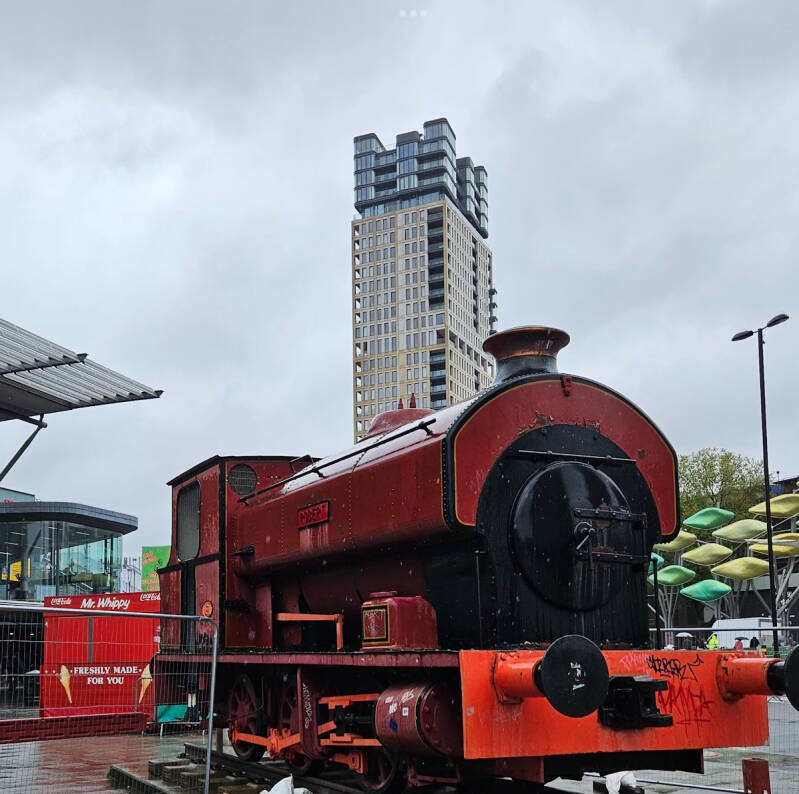




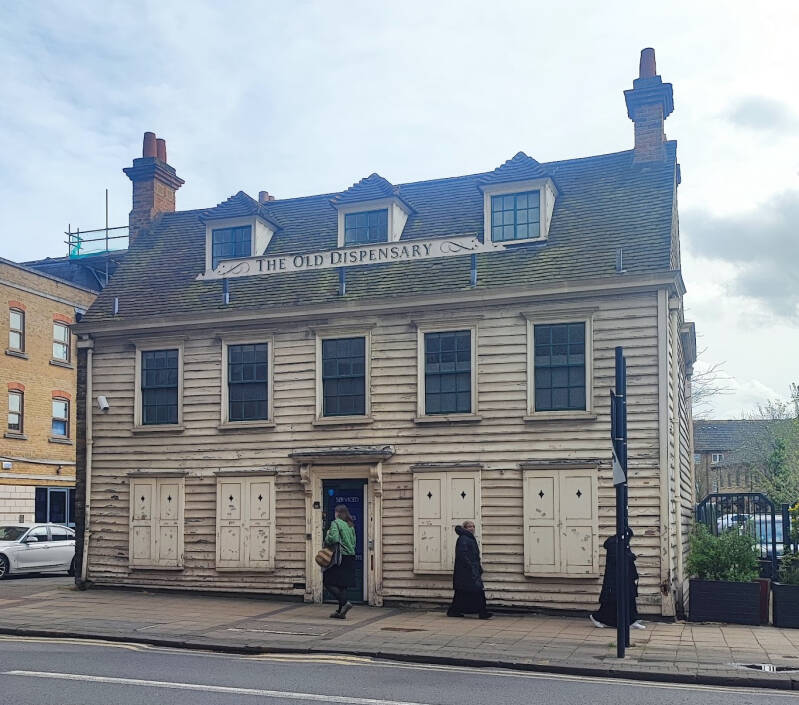
OLYMPIC PARK, NOW. RAILWAY WORKS THEN
STRATFORD INTERNATIONAL: SITE OF STRATFORD WORKS. RAILWAYS

Modern STRATFORD was built as a new town, initially called HUDSON TOWN (after railway entrepreneur GEORGE HUDSON where provided accommodation for the workmen).
Here were established the EASTERN COUNTIES RAILWAY and then the EASTERN RAIKWAY’s railway works. The first locomotives b. here in 1850 were passenger tank locomotives. J.V.GOOCH, brother of GWR’S DANIEL.
First recorded attempt at a compound locomotive.
The locomotive building plant gave way, after the grouping of railway companies, to repairs and major overhauls, and carriage works. In 1963 depot and works were closed. In 2007, coinciding with the opening of ST.PANCRAS INTERNATIONAL, was established here the maintenance depot for EUROSTAR’s UK sets
CHOBHAM MANOR. CHOBHAM FARM
A meat cold storage warehouse became the centre of national attention: in July 1972 a strike and picket on the site lead to the arrest and imprisonment of five trade unionists, known as the PENTONVILLE FIVE. The dispute spread nationally becoming a cause célebre for the trade union movement, and creating a political crisis.
VIC TURNER went on to be elected councillor and became MAYOR OF NEWHAM. He died in 2012. In 1973 a documentary , “ARISE YE WORKERS”, was produced by radical film group CINEMA ACTION
LEA VALLEY HOCKEY AND TENNIS CENTRE. FORMER ETON MANOR
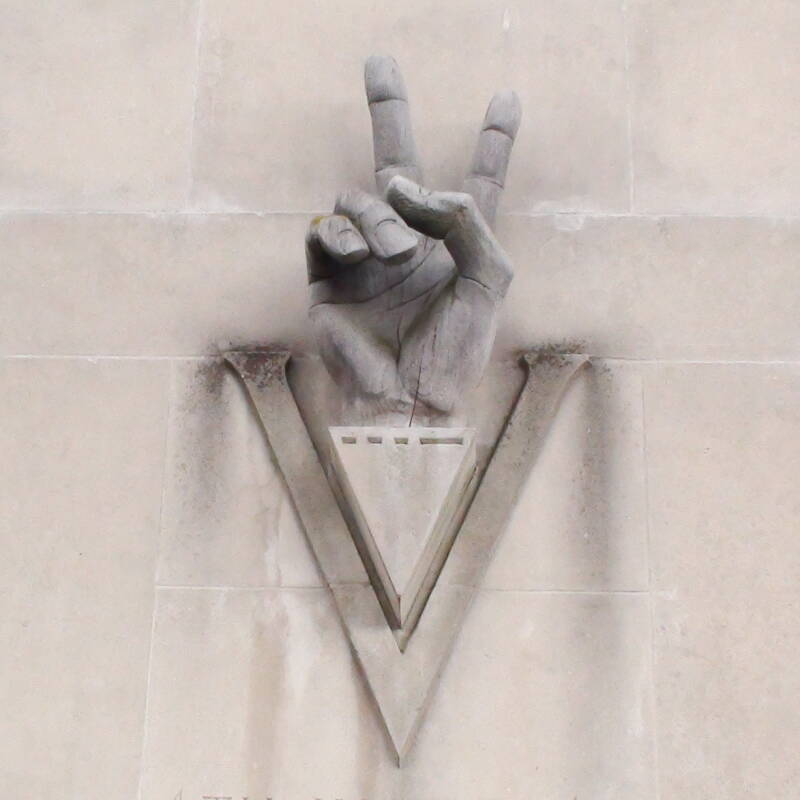
Eton Manor will always remember with gratitude the youth of this district who served under the dauntless and triumphant leadership of Winston Churchill.
WELCOME TO WALTHAM FOREST
NEW SPITALFIELDS MARKET

Britain’s premier wholesale fruit and vegetable market. The market is a purpose-built site, in Leyton, East London, which opened in 1991. It is the largest revenue-earning fresh produce and flower market in the UK.
direct and easy access to the motorway network, and all nearby ports and airports, enabling more than 100 companies to offer a range of healthy and nutritious fresh produce to their customers, sourced year-round from every corner of the world.
predominantly serve customers across London and the Home Counties
basket of fresh produce satisfies the culinary preferences of all cultures.
The depth and flavour of the New Spitalfields offer has been enriched by the presence of tenants specialising in exotic fruits and vegetables, as well as catering and food service firms serving public and private sector customers across London.
in 1682 King Charles II granted John Balch a Royal Charter giving him the right to hold a market on Thursdays and Saturdays in or near Spital Square.
From its small beginnings in the 17th Century, Spitalfields Market blossomed. Traders working from a collection of sheds and stalls did their best to meet the needs of London’s rapidly growing population and their appetite for fresh fruit and vegetables. Their success made Spitalfields Market a major centre for the sale of fresh produce, trading six days a week.
In 1920 the City of London acquired direct control of the market, extending the original buildings eight years later. For the next 60 years, Spitalfields’ nationwide reputation grew, as did the traffic congestion in the narrow streets around it. With no room for the expansion it so badly needed, the market was forced to move and in May 1991 it opened its doors at its new location in Leyton, east London.
TEMPLE MILLS
In 1185 William of Hastings, steward to Henry II, granted land here to the Knights Templar, who later built wooden watermills. After the dissolution of the order in the 14th century their property passed through a variety of hands (including the Crown’s) and milling and related agricultural industries continued to grow.
The area was crowded with WATER MILLS, straddling both sides of the LEA, HACKNEY and LEYTON. Beans, oat, barley, wheat and other Arable crops were the mainstay of the population and the base of the agricultural economy. And grain had to be milled.
Grinding rapeseed for oil was common here in the 17th and 18th centuries. As well: Processing leather, making brass kettles, twisting yarn, manufacture sheet lead.
GUNPOWDERproduction led to a tragedy around EASTER 1690. His mills and houses were blown up. He and his family and a French minister died in the blast.
SITE OF RUCKHOLT MANOR. LEYTON MILLS RETAIL PARK
It is claimed that a ROMAN military camp or “station” existed in the area. Descriptions of a double rampart, divided by a ditch, enclosing a circular embankment, on a small eminence, later planted with trees. A stone coffin was found here, but its location now is unknown.
Early ORDNANCE SURVEY maps show the site of RUCKHOLT (wood with rooks) where the ASDA car park is. The stream that crossed the site would have filled the moat of the MANOR HOUSE, providing with water supply and liquid waste disposal.
ELIZABETH I visites RUCKHOLT MANOR HOUSE, owned by MICHAEL HICKS, secretary to her CHIEF MINISTER LORD BURGHLEY, WILLIAM CECIL. He was knighted by JAMES I in 1604, when ROBERT CECIL had succeeded his father.
Farm buildings occupied the site once the manor, after years of decline, was pulled down.
FORMER ST.LUKE’S MISSION, NOW ST. ELEFTHERIOS GREEK ORTHODOX CHURCH
B. in 1914, to replace the original missionin grey terracotta. Became a parish in 1932.
Now, the spiritual centre of the Orthodox community, Greeks and non-Greeks, of EAST LONDON.
RUCKHOLT CLOSE
Victorian/Edwardian cottages
THANT CLOSE
Near RUCKHOLT HOUSE site
CORONATION GARDENS
Formally opened on 23 May 1903, commemorating the enthronement of KING EDWARD VII, thanks to a grant of £1000 From the LG BOARD.
There were times of civic pride and the filthy FILLEBROOK, an open ditch which ran through the area, had become a miserable eyesore.
It hosts the borough’s last surviving BANDSTAND in the borough, a cast-iron prefabricated structure made by MACFARLANES & CO of GLASGOW. A GLASGOW contractor restored it in 1999. Highly ornate balustrade.
The FOUNTAIN now is a replica of the 1920s one, which had replaced an original drinking fountain, but removed in the 1930s.
WAR MEMORIAL
DRINKING FOUNTAIN
GRASS SWARDS, GRAVEL PATHS, RAISED SHRUBED BEDS, RAILINGS and GATES with ornamental cast-iron posts.r
JACK CORNWELL GARDEN

BOY CORNWELL was born in Jan. 1900, in CLYDE COTTAGES. He is remembered by his gallantry at the BATTLE OF JUTLAND, for which he was awarded the VICTORIA CROSS, at only 16 years of age.
He had attended the FARMER ROAD SCHOOL (now GEORGE MITCHELL). The family moved to MANOR PARK.
After unsuccessful attempts, and against his family’s will! he managed to enlist in the ROYAL NAVY, in 1915, as a BOY SAILOR. He used letters of reference from his headmaster and an employer.
His was posted to the HMS CHESTER, which, on the 31st May 1916, came under intensive fire from 4 German marine cruisers. JC was serving as a sight setter on a gun mounting, when his post was affected by at least 4 nearly hits. The crew was killed and JC was wounded, but remaining at his post until the CHESTER retired from action. Medics arriving on deck found him with shards of steel penetrating his chest, but still waiting for orders while looking at the gun sights. He was transferred to GRIMSBY GENERAL HOSPITAL, dying on the 2nd of June 1916, before his mother could arrive.
The RN provided a coffin, his body being taken home and originally buried in MANOR PARK CEMETERY, marked “GRAVE 323”.
A month later, the DAILY SKETCH newspaper published a full front page spread telling of the “SCANDAL” of the young unrecognised war hero. The story captivated the hearts of the public and the RN decided that a FULL MILITARY FUNERAL would be given. This took place on the 20th July. After exhumation and funeral procession, he was required in MANOR PARK CEMETERY SQUARE. It followed the award of the VICTORIA CROSS, published in the LONDON GAZETTE.
His bravery inspired the creation of the CORNWELL SCOUT BADGE, still awarded today in response to high character and devotion to duty.
A number of streets and buildings are also named after him.
Here, a commemorative event took place on 26th May 2016, and a specially commissioned STONE was laid out.
LAURIE CUNNINGHAM
1956 - 1989, football legend, pioneering England international, played for Leyton Orient FC, 1974 - 1977.

LEYTON ORIENT FC
established as Glyn Cricket Club in 1881 by former students of Homerton College and named Orient in 1888 after the Orient Shipping Line. Renamed Clapton Orient in 1898, the O's moved to Brisbane Road in 1937 changing its name to Leyton Orient after WWII.
OLIVER ROAD ALLOTMENTS

Allotments are small parcels of land rented to grow fruits, vegetables and plants. Some people even use them to keep bees and smaller animals like rabbits and hens. Allotments can vary in size but the most common is ten rods or poles, which is an old Anglo-Saxon measurement roughly equal to 250 square metres. Read on…
LEYTON JUBILEE PARK
The largest park managed by Waltham Forest Borough Council. It was formed out of the merger of two green spaces, Ive Farm and Marsh Lane Playing Fields in August 2012.
The park's ecology includes scrub woodland, meadow, wildflowers and mature trees including poplars and london planes. Dagenham Brook is a river running along the eastern boundary of the park which is populated by such birds as kingfishers and little egrets.
The park's features include picnic, recreation and seating areas, playgrounds, an outdoor gym and a community cafe.[4]
DAGENHAN BROOK
The Dagenham Brook goes nowhere near Dagenham. Instead it's a very Waltham Forest kind of river, an artificial tributary of the River Lea dug for drainage purposes along the eastern edge of Leyton Marshes. Go back quarter of a million years and it's thought the Lea itself flowed this way, but now it's merely one of several ways that water flows from upstream of Walthamstow towards the Olympic Park. The
expansion of suburbia has made it a very urban river, tracking between the back gardens of E17 and E10, but still open enough in a couple of places to be quite pleasant.

The Parish Church of St Mary with St Edward and St Luke, Leyton, also known as Leyton Parish Church, that is the official name.
Records of the church go back to about 1200, it has been repeatedly rebuilt; the oldest surviving fabric dates to 1658 (TOWER), but a majority of it is from the early 19th century. THOMAS CUBITT did the building work.
The CLOCK looks out of place: it comes in fact from the GREAT HOUSE (which used to stand in CHURCH ROAD).
GILBERT DE MONTFICHET placed this parish into the care of STRATFORD LANGTHORN


The small chapel is a showy monument belonging to SIR MICHAEL HICKS and members of his family. There are effigies in alabaster with some painting.
CHURCHYARD

SIR FISHER TENCH, of the GREAT HOUSE. Son of NATHANIEL, GOVERNOR of the BofE, 1699~1701

BENJAMIN MOYER. Son and heir of SAMUEL, a member of a group ofcWHIG merchants and financiers who resented the TORY pro-court clicque’s dominance of the EAST INDIA COMPANY (SIR JOSIAH CHILD of WANSTEAD). The skull is carved on the gravestone and the cupola is similar to the church clock tower .
UNITED ALMSHOUSES
Originally founded in 1656 by the will of JOHN SMITH (a merchant, one of joint purchasers of the manor in 1649), an endowed by the parish (local parishes were anxious about minimising the expenses of looking after the poor and there are records of the LEYTON parish removing “a big bellied” woman out of its jurisdiction).
Now these 6 one bedroom cottages are managed by PATHWAYS, and rented to 60+ years old. A visiting care officer and a care line alarm service are included, in exchange of a rent paid to the social landlord.
This set of almshouses were rebuilt in 1885 in a TUDOR style by RICHARD CREED FRIBA, who also designed the nearby Essex Cricket pavilion. The Almshouses feature knapped flint work and early CRITTALL windows. CRITTALL was first manufactured in 1884 in ESSEX
At the rear of the ALMSHOUSES
SITE OF THE WORKHOUSE AND THE VESTRY MEETING ROOM
The WORKHOUSE was built in 1742. I’m mates picked oak rum, stripped feathers, spun flax, grind corn, crushed bones and gypsum, clopped wood, broke stones… and they were allowed part of the earnings.
There were 53 inmates in 1801.
Closed in 1836 when LEYTON joined forces with other parishes, joining the WEST HAM PARISH POOR LAW UNION and a new workhouse was built
VESTRIES met initially once a year, at Easter. Normally in a tavern. From 1759, monthly, in taverns and coffee houses
The LORD OF THE MANOR (HICKS) chaired the meetings until 1695. The vicar here, 1669~1737, was JOHN STRYPE, and he took often the chair. He was historian of the ENGLISH REFORM and collected documents of the TUDOR period.
Levying of the parish RATES and administration of the POOR LAWS were the Iain concerns of vestries
The Vestry provided a FIRE ENGINE, houses by the church porch
Alongside CHURCH ROAD
MOSAIC: MILLS ON THE LEA
ETLOE HOUSE. RESIDENCE OF CARDINAL WISEMAN
It is thought this was the site of a moated house called ‘Godsalves’. The current house was built on the site of the bowling green in 1760 by Edward Mores antiquary and printer. It has a 19th stucco-Gothic front. It was the home of William Bowyer friend of Dr Johnson and proprietor of The Gentleman's Magazine and from 1856 the country retreat of Cardinal Wiseman. It then became the St Agnes School and Orphanage until 1864 and its chapel was used as the local catholic church. Converted to flats and now surrounded by two- storey terraces. Lotus sculpture in the front garden
CHURCH ROAD SCHOOL
Across its front this proclaims that it was founded in 1876. It was probably funded in part from compensation paid in the 1870s by the Great Eastern Railway company because they were using some of the Lammas Land for their new railway
The ‘National Schools’ had been founded before state-funded education. They tried to keep their independence and their close association with the Church of England. In 1894 the only Council-run ‘board’ schools in Wanstead were those in the part of that local authority which was later transferred to Leyton, the ‘Wanstead Slip’ which included Cann Hall and Crownfield Roads 1. The Leyton School vBoard by then had schools at Kirkdale Road, Church Road and Harrow Green, Newport Road and Mayville Road. It went on to open schools at Lea Bridge Road (1891), Capworth Street (1896), Ruckholt Road (1898), Goodall Road, Connaught Road and Farmer Road (1900) and Davies Lane (1901) 3. In 1900 the Leyton National Schools had to give up the struggle against rates-funded education and accepted transfer to the control of the School Board
THE COTTAGE
ASSERTION OF LAMMAS LAND
The history behind this notice is that since the middle ages the marsh areas along the Ley/Lee/Lea valley were regarded as lammas land. This meant that the common people could pasture their cattle upon it from Lammas Day (Aug 1st) to Lady Day (March 25th) and from Lady Day to Lammas Day they could cut hay from that land and store it for winter food for their animals. During the 18th & 19th centuries when the rich land owners were enclosing common land, these lammas lands were under threat. From the 1850s the threat came from East London Waterworks Co and the Great Eastern Railway Co. On several occasions the companies paid compensation to the local board (Council) who used it for communal works. But in 1892 the Waterworks company laid rails across a bridle path without prior agreement. The commoners were furious and when the company failed to remove them, led by board members, they tore up the rails on Lammas Day. When the company sought to take legal action against them, they formed a Lammas Lands Defence Committee to oppose the company's parliamentary bill and so forced the company to negotiate.
At the end of Church Street, Lea Bridge Road
MILLENIUM CLOCK

CARNEGIE LIBRARY AND EXTENSION
Detail of the glorious tile decoration
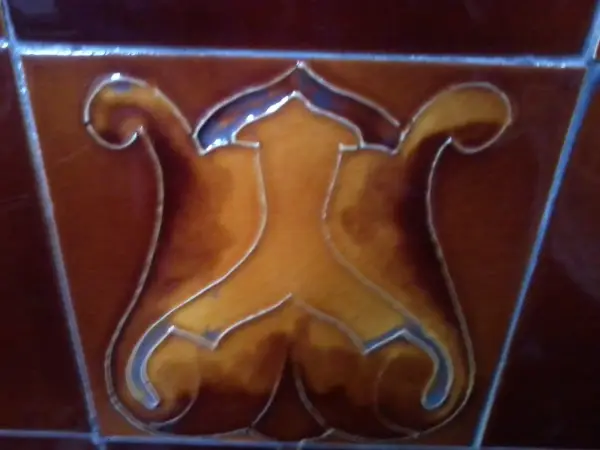
Carnegie funded the building of 2,509 "Carnegie Libraries" worldwide between 1883 and 1929. Of those, 1,795 were in the United States: 1,687 public libraries and 108 academic. Others were built throughout Europe, South Africa, Barbados, Australia, and New Zealand.
To the West: LEA VALLEY
WATERWORKS NATURE RESERVE
DAMSEL
RAILWAY TRACKS
Grange Park Road # Primrose Road
SITE OF THE GRANGE HOUSE and GROUNDS
Leyton Grange. The Grange dates from Domesday and was an outlying farm from the Abbey at Stratford Langthorne. A house stood on the north side of Church Road at the point which is now the junction with Grange Park Road. It is thought to have been demolished in the late 1640s although a gatehouse remained for a while. A new house was built in the early 18th by David Gansel which was home in the 19th to members of the Rhodes, developers and builders, family and later to the Charringtons, brewers, the estate was sold to the British Land Company for development in 1860The dip deep in the road marks the site of the ornamental lake of the GRANGE HOUSE.
Initially build by wealthy HIGUENOT DAVID GANSEL.
Later occupied by a MASTER OF THE ROLLS, a Governor of MARYLAND, and a lawyer and plantations owner
SITE OF CLYDE COTTAGES. JACK CORNWELL BIRTHPLACE


FORMER FARMER ROAD SCHOOL, NOW GEORGE MITCHELL

Farmer Road School was built during 1902 and opened on June 15th 1903 as a school for boys and girls of all ages. During the 1940s it became a secondary boys’ school, and remained so for 40 years. In 1986 it was reorganised again: it became co-educational, admitting both boys and girls from 11-16 years. And from September 2009, we merged with the former Beaumont Primary School to become George Mitchell School – an all-through school, providing an excellent, comprehensive and inclusive education to local children aged 3-16.
In 1957 the school was renamed in honour of George Mitchell, a student who had attended the school from 1923-1927. He won the VC during the Second World War. We maintain links with his regiment, the London Scottish Regiment. The VC medal, given to the school in 1959, was transferred to the London Scottish Regiment in exchange for a substantial donation towards the creation of community projects and space within the school, as well as 2 minibuses. Another student of the school won the VC – Jack Cornwell, the famous “boy hero” of the Battle of Jutland in 1916. We are possibly the only state school in Britain which can boast two VCs among its ex-students!
FIRST BRITISH INTERNAL COMBUSTION CAR, MADE HERE

Between 1892 - 1894 in a small workshop in the garden of this house, Fred Bremer and Tom Bates constructed the first British car powered by an internal combustion engine. In 1931 he donated it to Vestry House Museum where it can still be seen today.
WALTHAMSTOW CEMETERY
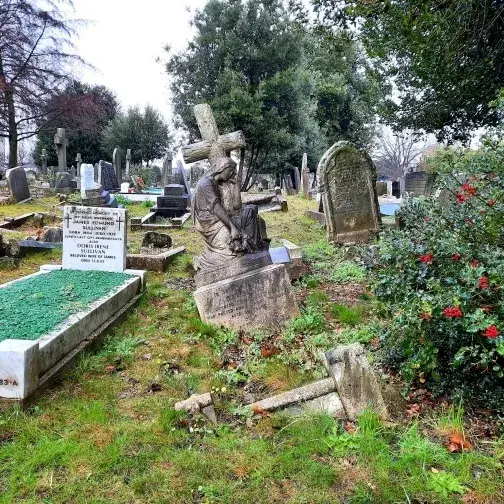
Walthamstow Cemetery opened in 1872 and is a bit of a strange one in that it appears to be sinking. A great number of the graves have been half consumed by the ground or have toppled over. Presumably this is down to lack of maintenance and subsidence. There is a petition from locals for the cemetery to be restored but it doesn’t look like they’ve had much luck yet.
One particular grave to look out for is that of Birt Acres (1854-1918)- a very early pioneer of cinema. He invented the first British 35mm moving picture camera and directed many early silent films. You can read more about him here. You can find his grave on the left side of the first right hand path as you enter.
WALTHAMSTOW QUEEN’S ROAD LU STATION


The Suffragette Line

The term was derived from the first wave of the campaign for women’s votes – the Suffragists. Together, with the Suffragettes, they paved the way for women’s rights, giving women a voice and the opportunity to vote. The line’s name pays especial homage to East London Federation of Suffragettes, which was a largely working-class suffragette movement in the East End. They campaigned for the rights of working-class women, and held public marches and meetings, produced a weekly newspaper and formed a small People’s Army to defend themselves from police violence.
A key member of the movement was Annie Huggett. She lived, campaigned and died in Barking at the age of 103, making her the longest surviving suffragette. Huggett was a pioneer who fought for votes when she was just a teenager. She even held tea for the Pankhursts, a family of leading suffragettes, at her home on King Edward’s Road. She organised meetings from the former George Inn in Barking Broadway – then the Three Lamps – a spot favoured by trade unionists and suffragettes. Her work helped empower women to have a significant impact on society, in the past, present and continuing into the future.
Today, women continue the campaign for equal rights. From the Women Activists of East London uncovering the real activists behind societal change in East London, to The Fawcett Society based in Bethnal Green, which campaigns for equal rights at work – such as closing the gender pay gap – as well as at home and in public life.
WALTHAMSTOW PUMPHOUSE MUSEUM


The Walthamstow Pumphouse Museum is a registered charity focusing on local transport and industry and is centred around a Grade II listed Victorian pumping station known as the 'Pumphouse'. The museum opened in 1997 when a group of local enthusiasts came together to restore the Grade II listed Marshall engines and form the Friends of the Pumphouse. However, the idea of operating a museum on the site was mooted as early as the 1970s shortly after the engines went out of service. The site was historically known as Low Hall Farm and an ancient manor house stood there for many centuries until it was bombed in WWII. The site was part of a much larger council depot part of which is still in existence
The museum focuses on the pioneering breakthroughs in road, rail, air and sea transport, that occurred in Waltham Forest and the surrounding area,. These achievements include the first British motorcar[3] and the first all British aircraft, which first flew from Walthamstow Marshes.
The museum gives a fascinating insight into the role played by the area. Arthur Salisbury-Jones, who was a member of the Stock Exchange, had an idea of starting a large-scale motorbus company to serve London’s commuters, which if successful, he would expand to cover the whole of Britain. In 1905 he launched the London Motor Omnibus Company, which was so successful that other bus companies were quickly introduced to the metropolis. By the middle of 1907, Salisbury-Jones had over three hundred passenger-carrying vehicles on London’s roads. At the onset, Salisbury-Jones recognised that to achieve his aims and objectives, he would need to control closely the manufacture and design of his vehicles. This he did by forming the Motor Omnibus Company in 1905 and in the following year a small tin hut was rented out in Hookers Lane, Walthamstow, London. Initially, parts were purchased from a range of outside contractors to be assembled into vehicles. However, by 1907, a new 30,000 square foot factory was opened at Hookers Lane, which brought in-house much of the work provided previously by outside suppliers. By the following year the factory had doubled in size and the workforce had increased from six in 1906 to over five hundred and seventy.
Low Hall Pumping Station, a Grade II listed building, originally built as a sewage pumping station in 1885.[1][2]
THE LIGHTHOUSE METHODIST CHURCH

The Lighthouse Methodist Church was built in 1893 to accommodate Walthamstow’s growing population brought on by the growth of the railways. It’s founder was Captain King of the King, Bullard and Company ship liner company, hence the quirky lighthouse design. Apparently the lighthouse used to have a revolving beacon that would shine out during Sunday services!
To the West
ST.JAMES’S LO STATION
The Weaver Lane
The Liverpool Street to Cheshunt/Enfield Town/Chingforg line was renamed The Weaver line as it runs through EAST END areas (Spitalfields, Bethnal Green and Hackney) - which were known for their textile trade, and shaped over the centuries by diverse migrant communities and individuals. It will be maroon parallel lines on the map.





This route is links HERE to
SPRINGFIEKD PARK

COPPERMILL LANE

HIGH STREET

WALTHAMSTOW VILLAGE


You are now in CENTRAL WALTHAMSTOW



FORMER TOWN HALL, now LIBRARY

1882. JOHN KNIGHT, arch.
In a period of population expansion (+58%, 1891-1901), of civic pride and rivalry between East London districts that were leading then to build grandiose town halls.
An striking building, with ITALIANATE touches. Highly ornate, showy: Frieze, panels, scrolling panels.
SECOND TOWN HALL

designed by JOHN JOHNSON in a rich eclectic style after a competition involving over thirty entries. Erected 1894 - 6 to replace the original public offices,
In a period of population expansion (+58%, 1891-1901), of civic pride and rivalry between East London districts that were leading then to build grandiose town halls.
FROM VESTRY to LONDON BOROUGH

Leyton St Mary or Low Leyton (sometimes spelt "Layton")[1] was an ancient parish in the Becontreehundred of Essex.
PARISH VESTRY. From the 17th century, the local government of Leyton was increasingly controlled by the parish vestry, particularly with regard to the administration of the Poor Laws and levying of the parish rates.Public Health Act, 1872, adopted.
Although the main Easter meeting was held in the parish church vestry room, other meetings were held in pubs or coffee houses, the committee members being entitled to a generous entertainment allowance of 40 shillings twice a year, although this was halved in 1723. Originally the meetings were presided over by the lord of the manor of Ruckholt, until 1695 when the Vicarof Leyton took on that role. A parish clerk is first mentioned in 1623.
LOCAL GOVERNMENT DISTRICT. 1873. Leyton was a local government district in southwest Essex, England, from 1873 to 1965.
1894. LEYTON became an URBAN DISTRICT under the LOCAL GOVERNMENT ACT.
In 1905 the UD BOARD initiated the TRAMWAY network.
Urban districts in the outer London area were absorbed into London Boroughs in 1965 as a consequence of the London Government Act 1963.

FORMER TECHNICAL INSTITUTE, now FLATS and other uses
A range of technical education buildings, 1898-1938. Very much of a piece with TOWN HALL, but lower and simpler. A single decorative panel (though more were planned) depicts a student and workmen.
Central IONIC porch. Pedimented with elaborated finial.
Blind arcades, stone lined niches, rich frieze cornice, decorative gable, pinnacles, octogonal corner buttresses, timber and lead flèche, continuous arcade, pediment, pavilion roof.
Day school for boys and girls, secondary school providing commercial subjects (geography, correspondence, bookkeeping, shorthand) and needlework and cooking. Courses for 16+ in art, science, trade.
In 1916 the secondary school moved out, replaced by an engineering and trade school.
By 1928 the new LEYTON TECHNICAL COLLEGE provided 3 years courses for 12+ boys. In the 30s nationally recognised certificates in chemistry, building, mechanical and electrical engineering were provided.
In 1934 this was a very popular centre, where 2.134 students followed technical and art courses, but a survey deemed the building unsuitable for expansion. As no suitable site was found around LEYTON, the new SW ESSEX. TECHNICAL COLLEGE was build in WALTHSMSTOW, in 1938.

WALNUT TREE HOUSE. OLDEST BUILDING IN LEYTON

SITE OF LEYTON GREAT HOUSE
LEYTON CRICKET GROUND
The ground was the headquarters and main home match venue of Essex County Cricket Club from 1886 until 1933, and was also used by the club for matches between 1957 and 1977. It currently hosts club and community cricket matches and has a listed pavilion.
SITE OF LEYTON GREAT HOUSE (542-548 HIGH ROAD)
LEYTON MIDLAND ROAD LO STATION


Wesley Rd
BIRTHPLACE OF HARRY BECK
Harry Beck was the designer of the iconic London Underground map. First published in 1933, the map has since influenced the design of many Metro maps across the globe.
He took the existing geographically based map and straightened the distinctive colourful lines – the ‘vermicelli’, as he later called them – to verticals, horizontals or 45 degree diagonals. The typeface used was a variant of Edward Johnston’s distinctive ‘Underground Railway Sans’ of 1916 (the same used in THIS BLUE PLAQUE), and the only topographical feature shown was a schematised River Thames.
Beck was notably ahead of the game in producing a version of his London map showing all train services, underground and overground, as early as 1938. But it was never used, and nor were the elegant prototypes he produced for a map of the Paris Metro.
THE WILLIAM IV PH

TESCO ARTWORK
CAT & DOG (A PET SURGERY)
BAKERS ALMSHOUSES

SITE OF BATHS.
Foiled in its plan to destroy the almshouses, Tesco instead demolished Leyton baths in 1994 and opened an unsightly superstore here.
LEISURE CENTRE.
A short distance to the south, Leyton leisure lagoon became the principal local amenity. This was revamped in 2013 and reopened as Leyton leisure centre.
FORMER BAKERS ARMSXPH.
Though the Bakers Arms pub has been converted to a bookmakers, Wetherspoon’s The Drum is located a few doors to its west.
FORMER TRAM DEPOT. A KFC now occupies the site of the tramway depot.
Commissioned by Waltham Forest council, a £370,000 regeneration project resulted in some stylish improvements to the crossroads’ street-facing properties and the public realm in 2013–14.
According to the 2011 census, the residential population of the Bakers Arms locality is ethnically diverse, with no single group constituting a majority. The most populous sub-group is Pakistani or British Pakistani, representing about 30 per cent of the total. Residents of white British, Polish and other Eastern European, African, Caribbean and Vietnamese heritage are also relatively numerous.
To the East of LEYTON HIGH ROAD
GREENWICH MERIDIAN LINE: 2 REFERENCES
MARKERS
NOTTINGHAM ROAD
MERIDIAN HOUSE (COLLEGE)
ESSEX ROAD
Lea Bridge Road junction. Here starts the route along HOE STREET to WALTHAMSTOW CENTRAL
WALTHAMSTOW HIGH STREET: THE LONGEST STREET MARKER

And now the route takes you Northwards to WILLIAM MORRIS GALLERY and LLOYDS PARK
WILLIAM MORRIS HALL
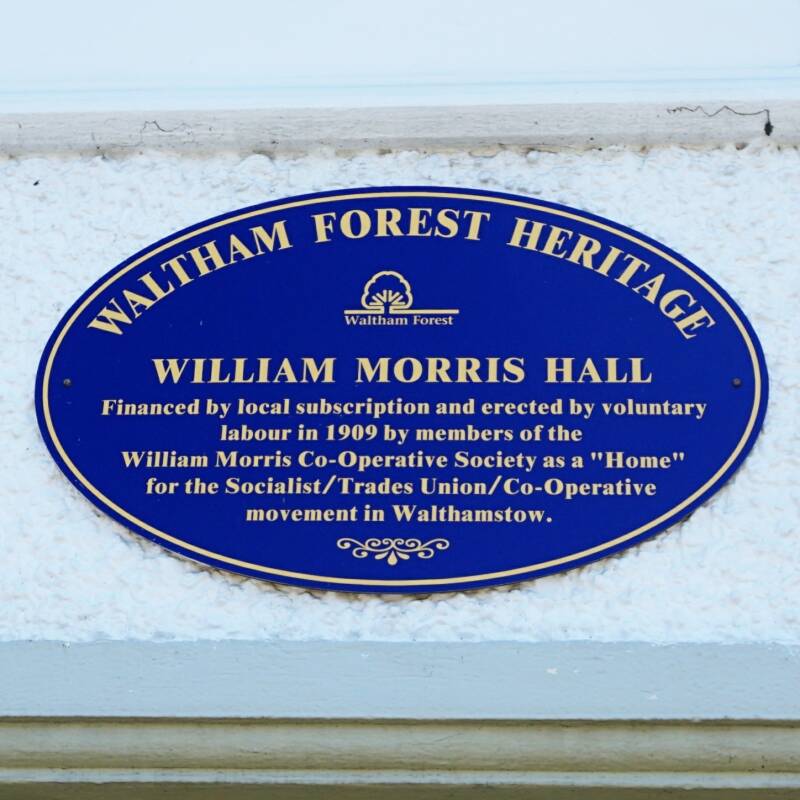

THE LORD PALMERSTON PH

On the corner of Forest Road and Palmerston Road. Lord Palmerston (1784-1865) was prime minister from 1855-1858 and from 1859-1865, but is probably better known for his long period as Foreign Secretary. He followed an interventionist policy and was the inventor of gunboat diplomacy. His actions were regarded by some as abrasive, and as a result was sometimes referred to as Lord Pumice Stone. He started his political life as a Tory, but eventually founded the Liberal Party. There is a statue of him in Parliament Square.
FOREST ROAD

Forest Road is a busy route used by up to 17,000 vehicles daily and is home to around 3,600 residents and 340 businesses. It’s a key route in Waltham Forest connecting Woodford New Road to Ferry Lane and is already an important walking and cycling route that helps people get to key places like the William Morris Gallery, Lloyd Park, Walthamstow Wetlands and other local facilities.
To make this road safer for all road users we’ve made significant improvements to the full route, since 2016, including upgrading all major junctions, new pedestrian and cycle crossings, new bus facilities, blended crossings, segregated cycle lanes and new public spaces.
In 2016, initial improvement works started on the section of Forest Road near to the boundary with Haringey, to support the opening of Walthamstow Wetlands.
SITE OF ELM HOUSE. WILLIAM MORRIS BIRTHPLACE



MARKET

VLLOYDS PARK


WILLIAM MORRIS GALLERY


CAFÉ

ARTISTS STUDIOS

WOOD















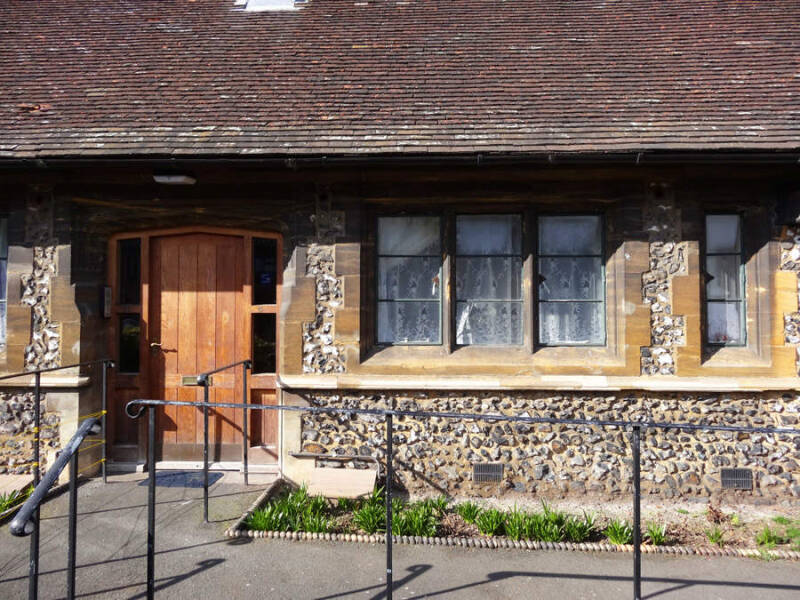
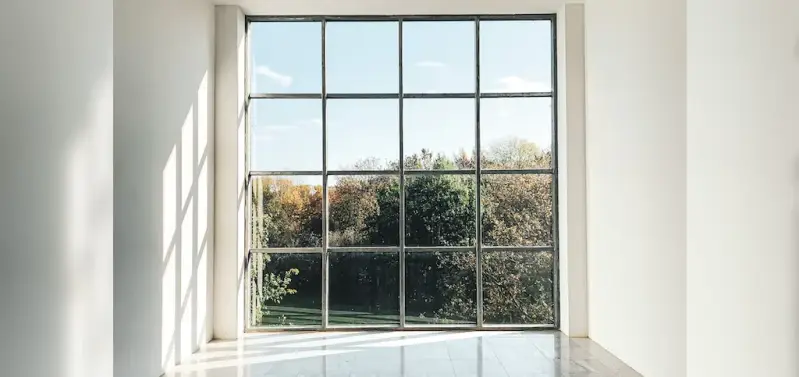













Create Your Own Website With Webador